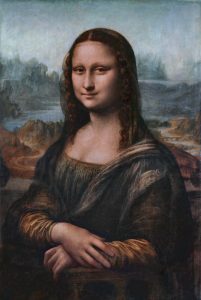 Written by Jood, Teen Volunteer
Written by Jood, Teen Volunteer
Halifax Public Libraries' Teen Blog is written by and for teens. Discover more posts here.
To sell it short, the Mona Lisa is essentially a portrait painted by Leonardo da Vinci in the early 1500s but… do we really know the Mona Lisa (or should I say Mona Lisas)? Before you start reading this, think to yourself; have you ever been taught anything about the history of the Mona Lisa or any other works of art? If not, it’s probably the reason why you’re not interested in it. Art isn’t just about brush strokes—it’s the way people tell stories, show emotions; the way an artist thinks, breathes, sees and imagines. I have done two art projects based on the Mona Lisa, and looking back, I never really thought it was anything more than an old painting.
But, the Mona Lisa is surrounded by endless mysteries ("endless" because we are still discovering more and more about this painting every day!). I mean, almost everything about this portrait has some sort of meaning behind it.
Just imagine yourself painting a portrait. Would you paint the background so thoughtfully that you paint bridges and scenery from multiple different places you’ve been to, or just draw some trees and call it a day? There is so much to learn about this piece but I think starting with the things you never thought twice about is a more interesting place to start than you might think…

Some little things
- The Italian title translates to "My Lady" or "Madam Lisa."
- Most people believe that Leonardo painted Lisa del Giocondo as the model of the portrait for her wealthy Florentine silk merchant husband, Francesco del Giocondo. But some believe that the infamous eyes that follow you, might not even be hers!
- Some speculate that Leonardo himself is the model of the Mona Lisa but in a more “feminine” or “drag” version of himself.
- The years when Leonardo painted it are widely suggested to be 1503-1506. Yet, many argue that he started in 1513 but after four years of work he left it unfinished.
- Others believe that the characteristics of the painting, in terms of detailing and style, are those of Leonardo’s final years.
These examples, to me, are a huge example of why art is so important and interesting. Through his paintings, people who never knew Leonardo da Vinci, are able to tell when in history it was painted, when in his life it was painted—all because of how clear his patterns of self expression are.
Multiple versions
Because Leonardo was a teacher, his pupils/apprentices are believed to have painted alongside him during the commission of the Mona Lisa. Leonardo himself also would make multiple versions of his famous piece.
Art critics have continuously argued about the authenticity of the current Mona Lisa displayed. But Leonardo also gave us the Isleworth Mona Lisa, opens a new window that was hidden in a Swiss Bank Vault for over 40 years. This preserved the paint, showing us what the original Mona Lisa used to look like. There is also the Vernon Mona Lisa, opens a new window, which is also a much brighter version of the famous Mona Lisa. I personally find the Prado Mona Lisa, opens a new window most interesting because Leonardo did not paint it. It is believed that a Spanish student of his, either Fernando Yáñez de la Almedina or Hernando de los Llanos painted it alongside him. Before it was restored, the background had completely turned black making it easy to believe that it was just a copy. Then during its restoration, through the way the artist used his own skills and techniques, we could tell who painted it, which is honestly mind-blowing to me.
My thoughts
Appreciating the details of the Mona Lisa is something everyone can learn from and take into whatever art form you like to create or appreciate. It doesn’t take the most detailed skills to create art that you are passionate about and that represents you as an artist.
I find that it becomes difficult to understand what art means to you when you don’t know what art is. But by observing the artist’s forms of self expression, appreciating and researching the history behind it, and also thinking about how it makes us feel—only then can we come close to saying we understand art. Next time you come across a piece of art in school or scrolling through social media, try finding a book or an article about it. You might just find yourself more interested in the art than you thought you would be!
Resources
If you're interested in reading more about the Mona Lisa, you can visit these websites where I found my information.
Culture Trip Article, opens a new window
Wikipedia - Mona Lisa, opens a new window
Wikipedia - Speculations about the Mona Lisa, opens a new window
Mona Lisa - Multiple Versions, opens a new window
About the writer
My name is Jood Shikara and I’m 15 years old. I'm currently in COVID-19 quarantine just like you. I have a dwarf hamster named Sesame who lives luxuriously. My life these days tend to centre around him and I am not mad about it! I’ve always thought learning was really fun but I like learning specifically about things that they don't teach you in school, like how to take care of a hamster! I love trying and learning about different styles of art because I want to channel my creativity in new and interesting ways.


Add a comment to: Mysteries of the Mona Lisa